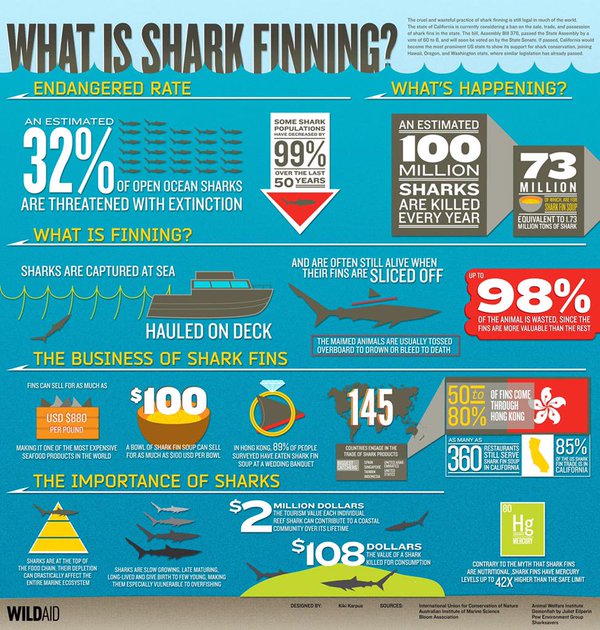Wildlife Forensics is an activity developed by Learning Undefeated to help students explore forensic science and DNA analysis.
Shark fins are in incredible demand in Asia, costing hundreds of dollars a pound to be used in soups. In order to collect fins, poachers will catch sharks and de-fin them, often throwing the harmed sharks back into the water where they are unable to swim properly or survive. Due to the greatly dwindling shark populations, the U.S. government protects certain species, like the great white, and has made it illegal to hunt and trade them. Unfortunately, bringing those who illegally kill great white sharks to justice is not an easy task. It is often impossible to visually identify what species a shark fin belongs to, especially when the fins have been dried and processed.
In this lab, students will compare the DNA fragment(s) in a sample of DNA from a package of fins to great white and porbeagle shark DNA controls to determine if your unidentified fin is from a great white shark.
Students will be able to
- Students will analyze DNA extracted from unknown shark fins in order to determine if the fins were harvested from a protected species of shark.
- Describe how the illegal shark trade is effecting the great white shark population
- Classify a shark as a great white or not based upon the PCR results and gel electrophoresis
Next Generation Science Standards Connections
HS-LS1-1: Construct an explanation based on evidence for how the structure of DNA determines the structure of proteins, which carry out the essential functions of life through systems of specialized cells.
HS-LS4-1: Communicate scientific information that common ancestry and biological evolution are supported by multiple lines of empirical evidence.
HS-LS4-5: Evaluate the evidence supporting claims that changes in environmental conditions may result in (1) increases in the number of individuals of some species, (2) the emergence of new species over time, and (3) the extinction of other species.
Texas Essential Knowledge and Skills for Science Connections
AQSC.12D: analyze and discuss how human activities such as fishing, transportation, dams, and recreation influence aquatic environments.
AQSC.12E: understand the impact of various laws and policies such as The Endangered Species Act, right of capture laws, or Clean Water Act on aquatic systems
BIOL.6A: recognize that components that make up the genetic code are common to all organisms.
BIOL.6B: recognize that components that make up the genetic code are common to all organisms
BIOL.7A: analyze and evaluate how evidence of common ancestry among groups is provided by the fossil record, biogeography, and homologies, including anatomical, molecular, and developmental
BIOL.12E: describe how environmental change can impact ecosystem stability.
E.4G: predict how species extinction may alter the food chain and affect existing populations in an ecosystem.
E.9K: analyze past and present local, state, and national legislation, including Texas automobile emissions regulations, the National Park Service Act, the Clean Air Act, the Clean Water Act, the Soil and Water Resources Conservation Act, and the Endangered Species Act
Virginia Science Standards of Learning
BIO.6A: organisms have structural and biochemical similarities and differences
BIO.8A: interactions within and among populations include carrying capacities, limiting factors, and growth curves
Activities to Gather Evidence
US Fish and Wildlife Lab
Tour the lab, learn about evidence collection and preservation, read about US statutes and laws pertaining to wildlife, and much more
Shark Savers
Information on the shark’s role in the aquatic food chain
Dr. Mahmood Shivji
Learn about the man behind the method. Explore Dr. Shivji’s work and read the original peer reviewed article explaining the science behind the technique
WildAid.org
Learn about an organization dedicated to ending the illegal wildlife trade. Explore volunteer and internship opportunities all over the country
PCR Tools
Animation of the PCR process
An interactive animation of PCR
Gel Electrophoresis Tool
Run a virtual gel electrophoresis

